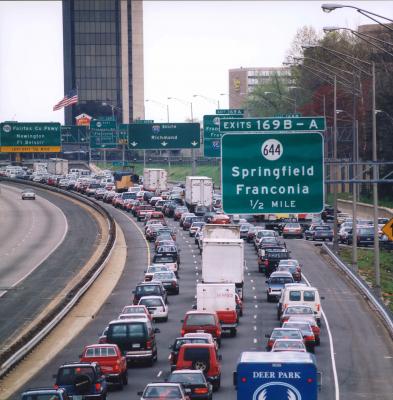The entire idea of the “commute” would seem ridiculous in an earlier time. People didn’t live 100 miles from where they worked. With the introduction of a large nationwide highway system and the availability of cheaper cars, the commute was born. People flush with money from the GI bill and savings from the hard times of WW2 moved en masse to new “suburbs.” Planned cities where everyone got a small yard, a garage, and the world was perfect, or was it?
With the move away from city centers, and rapid increase in the number of cars on the road, it soon became clear that no amount of roads could handle the ever growing number of cars trying to cram on to them. Ever feel like you spend your whole life stuck in traffic? Well you are not alone: with the increase in the number of cars on the road, traffic congestion continues to worsen in American cities of all sizes. This gridlock is creating a $78 billion annual drain on the U.S. economy in the form of 4.2 billion lost hours and 2.9 billion gallons of wasted fuel—that’s 105 million weeks of vacation and 58 fully-loaded supertankers.
Talk about waste. A gallon of gas has about 19 pounds of CO2, meaning that 2.9 billion gallons of gas wasted means 55.1 billion pounds of CO2 needlessly pumped into the atmosphere every year.
These are among the key findings of the Texas Transportation Institute’s 2007 Urban Mobility Report. Improvements to the methodology used to measure congestion nationwide have produced the most detailed picture yet of a problem that is growing worse in all 437 of the nation’s urban areas. The current report is based on 2005 figures, the most recent year for which complete data was available.
This traffic has a lot of causes: bigger cars, more cars, people living farther from where they work, people no longer taking public transportation, and poor design of roads and cities to handle this increased traffic. “There is no ‘magic’ technology or solution on the horizon because there is no single cause of congestion,” noted study co-author Tim Lomax, a research engineer at TTI. “The good news is that there are multiple strategies involving traffic operations and public transit available right now that if applied together, can lessen this problem.”
As they say, time is money. The 2007 mobility report notes that congestion causes the average peak period traveler to spend an extra 38 hours of travel time and consume an additional 26 gallons of fuel, amounting to a cost of $710 per traveler. Along with expanding the estimates of the effect of congestion to all 437 U.S. urban areas, the study provides detailed information for 85 specific urban areas. The report also focuses on the problems presented by “irregular events”—crashes, stalled vehicles, work zones, weather problems and special events—that cause unreliable travel times and contribute significantly to the overall congestion problem. Worsening congestion, the study notes, is reflected in several ways:
- Trips take longer
- Congestion affects more of the day
- Congestion affects weekend travel and rural areas
- Congestion affects more personal trips and freight shipments
- Trip travel times increasingly are unreliable
Researchers spent two years revising the methodology, using additional sources of traffic information, providing more—and higher quality—data on which to base the current study. The report identifies multiple solutions to the congestion problem that, researchers say, must be used together to be effective. These include:
- Get as much service as possible from existing infrastructure
- Add road and transit system capacity in critical corridors
- Relieve chokepoints
- Change usage patterns
- Provide choices
- Diversify the development patterns
- Keep expectations realistic
With the increasing cost of oil, and the consequences of this wasted time, money and fuel, combined with the horrible ecological cost of this waste, it is clear that the current system is not sustainable. In my mind, the most important changes are changing use patterns, and diversifying development patterns. The creation of bike routes and walking paths will allow people who live close to ride their bikes to work, or walk. Building mixed zoned places will allow people to have a house near the place they work.
How is your commute? Do you spend a large amount of time in your car each day watching the traffic jam move slowly? What would you do to solve traffic jams? Want more highways in your neighborhood? Would you install bike lanes? More bus routes? Leave a comment with how you beat the daily gridlock.

My commute is fantastic now. I work across the street from where I bought a condo, so I just walk to work now. I biked the 2.5km before this job, and before then I biked the 3km or car pooled in Winter. I can’t imagine fighting traffic every day and commuting more than ~20minutes one way while keeping my long term sanity and energy.
My commute sucks – 1:15 or more each way – Phoenix metro, so snowbirds and winter vacationers make it much, much worse, come January. Don’t even think of trying to get home reasonably on holiday eves (or Holloween). Frustrating part is that for 90% of my job, I could telework no problem. Can’t afford to move closer, nor to change jobs right now, though that last is my goal. Insanity includes express buses that only run into downtown PHX mornings and out in the afternoon. I could bus that far, and would, but it would take me another two hours to get to the job on the far side of downtown… Waiting for light rail and loop bus/bike combos in the meantime.